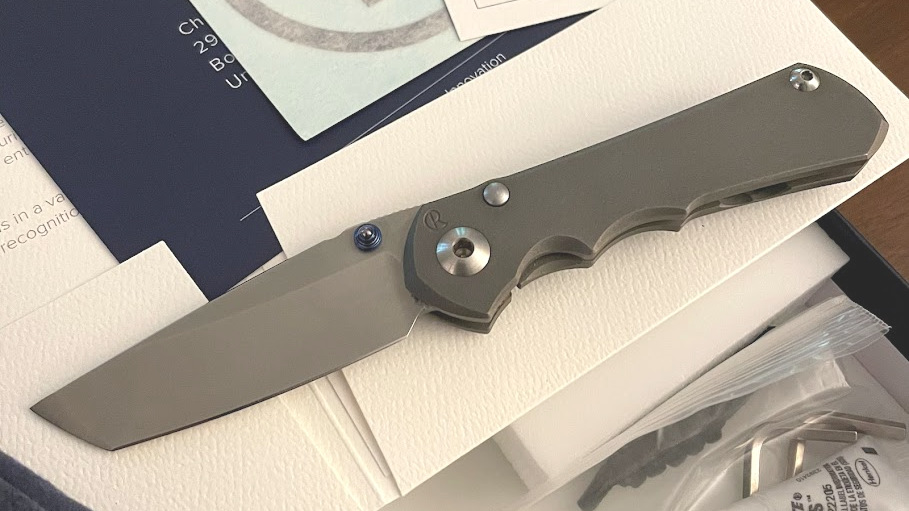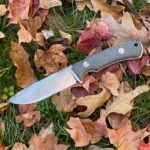
In the vast list of things Rybo never thought he would care about – high end tanto blades are definitely up there. I thought tanto’s were one of those things I outgrew early in my knife addiction, but for some reason I recently found myself staring down at this.

Yikes – that’s like…$700+ of beautiful tanto! That CRK grind just hits different.
In all seriousness, this is as much a review of the Inkosi – I suppose specifically the small Inkosi, as it is the tanto blade shape. I have been a huge fan of Sebenza’s for several years, and to be honest I always frowned on the more complex-looking Inkosi platform. It seemed impossible to me that the finger grooves would work well between the small and large sizes, or that they would be forgiving enough to accommodate multiple hand sizes or grip styles.
But, I was wrong. The Inkosi is an insanely comfortable and practical knife platform that exceeds my expectations in nearly every category. That said…I no longer own either of the 2 in the picture above. That’s partly due to the fact that I’m constantly flipping knives, partly due to my extreme loyalty to the Sebenza, and partly because of a few shortcomings I ultimately found in this platform. But first, the good.
The Inkosi impressed me right off the bat with stellar ergonomics. The small, in particular, was surprising because I tend to hold smaller utility knives like this in varied grips depending on what I’m doing. But every way I held it, things felt great. The large version is even more comfortable, with ample room for a full grip and more than enough handle material to keep your fingers from feeling cramped.

Likewise, the overall aesthetics really appeal to me – particularly the small. There’s a charmful stubbiness that screams utility. I’ve now owned small CRK’s in the drop point, insingo and tanto blade shapes. The drop point is, in my opinion, the most beautiful. The insingo is the most useful. And the tanto is the coolest – by far. I’ve tried 31 inalys, 21 inlays and plain jane on both Sebenza’s and Inkosi’s. Visually, the inlay always looks great, but practically I’ve found that I much prefer the “plain jane” CRK’s.
As always, I’m a super-duper fan of the ceramic detent ball interface found on the 31 Sebenza’s, the Umnumzaan and the Inkosi’s. There’s nothing else like it in the knife world, and until you try one in person you really just won’t “get it”. I hope that time validates this statement – but I expect this lock interface to age very gracefully and create smooth and consistent action throughout the years.
Finally, the thing that makes the small Inkosi such an appealing knife to me personally is…as always…overall utility. It’s just so practical – both in cutting performance and overall size. It’s small – really small, like smaller than the oft-ridiculed small Sebenza. But in this case – particularly with an insingo or tanto blade – that’s an amazing thing. This doesn’t need to be a primary knife, but it could easily be. It accomplishes just about everything I need to do on a normal day, and I barely notice it in the pocket. The singular downside I find in the size of the small Inkosi is easily the difficulty I have in opening it consistently. I struggle in general with small CRK’s and the weird thumbstud, and the Inkosi is just cramped enough to make it more frustrating for me.

Sadly (and I do truly mean sadly…I do not disparage CRK lightly), the Inkosi as a platform ultimately falls short for me for one reason: complexity. There is a great and terrible irony to ingenuity – when we set about to solve problems, we often create 3 more. Sadly, this is the case (in my opinion) with the Inkosi. See, the Inkosi is the current “flagship” model of CRK – at least nominally. It is designed to be the most advanced knife they offer, robust and complete in every way – the “Chief”. And it is. Featuring an enhanced grip, the newest lock interface, a better washer system, etc – the Inkosi really is a beast.
However, that beastliness comes at a complexity cost that had some frustrating consequences for me. The new pivot system is free-spinning, and the knife kit comes with 2 Allen wrenches, as well as purple Loctite. The inference here is that you will need to use both wrenches against each other to open and close the pivot, and that Loctite is recommended to ensure these 2 screws don’t loosen from each other over time. Complexity.
I owned these 2 knives for the better part of 6 months, and I carried them often. There was a period of time when the large Inkosi was my daily carry knife, and I truly thought it was unseating the Sebenza. And then…the knife came apart. I found this out the hard way one day when I was outside working and pulled out my large Inkosi to cut something. I noticed some significant blade play, and realized that the pivot had loosened. This was especially frustrating, because I was in the middle of some chore, and the double Allen wrenches were sitting upstairs in a box somewhere. Within a few weeks, the same thing happened to my small. While it’s not a huge deal – the fix takes 3 seconds with the right tools – the disassembly is more complicated than a Sebenza, and it requires the extra step of Loctiting the pivot or constantly checking/adjusting the screws over time.
Ultimately, as much as I truly love the Inkosi, I just have no desire to carry a fussy knife, and that’s how I genuinely felt about the Inkosi after 6 months of carry. It’s not wife material – great in a lot of ways, but high maintenance. It may not be my last Inkosi, but I’ve added 1 Sebenza since offloading these 2, and I see more of those in my future before I circle back to the Chief. Cut.







Did the two Inkosis that came apart have loctite applied to the pivot screws?
Sorry for the late reply – I am not positive about the first one, as I had purchased the knife second-hand and hadn’t disassembled before it happened. But the second instance, yes. I had personally applied some of the purple Loctite that comes in the CRK box, and it eventually broke free.